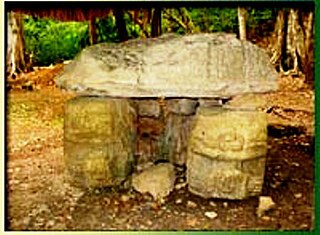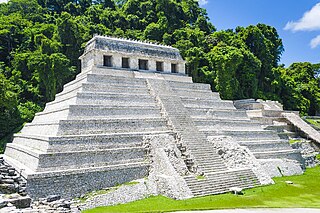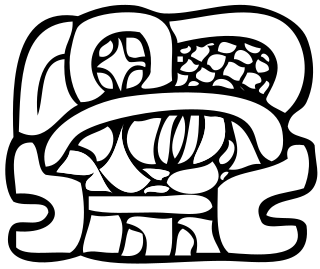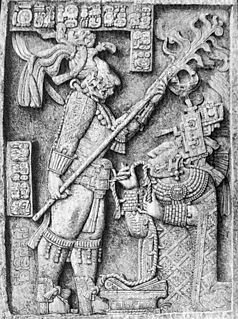
Piedras Negras is the modern name for a ruined city of the pre-Columbian Maya civilization located on the north bank of the Usumacinta River in the Petén department of northeastern Guatemala. Piedras Negras is one of the most powerful of the Usumacinta ancient Maya urban centers. Occupation at Piedras Negras is known from the Late Preclassic period onward, based on dates retrieved from epigraphic information found on multiple stelae and altars at the site. Piedras Negras is an archaeological site known for its large sculptural output when compared to other ancient Maya sites. The wealth of sculpture, in conjunction with the precise chronological information associated with the lives of elites of Piedras Negras, has allowed archaeologists to reconstruct the political history of the Piedras Negras polity and its geopolitical footprint.

El Perú, is a pre-Columbian Maya archeological site occupied during the Preclassic and Classic cultural chronology periods. The site was the capital of a Maya city-state and is located near the banks of the San Pedro River in the Department of Petén of northern Guatemala. El Perú is 60 km (37 mi) west of Tikal.

Lintel 24 is the designation given by modern archaeologists to an ancient Maya limestone carving from Yaxchilan, in modern Chiapas, Mexico. The lintel dates to about 725 AD, placing it within the Maya Late Classic period. The text of Maya hieroglyphics indicates that the scene depicted is a bloodletting ritual that took place on 5 Eb 15 Mac, 709 AD. The ruler, Shield Jaguar, holds a torch while his consort, Lady Xoc, pulls a rope studded with what are now believed to be obsidian shards through her tongue in order to conjure a vision serpent.

Ek' Balam is a Yucatec-Maya archaeological site within the municipality of Temozón, Yucatán, Mexico. It lies in the Northern Maya lowlands, 25 kilometres (16 mi) north of Valladolid and 56 kilometres (35 mi) northeast of Chichen Itza. From the Preclassic until the Postclassic period, it was the seat of a Mayan kingdom.

Pajaral, otherwise known as El Pajaral, is the modern name for a mid-sized ruined city of the pre-Columbian Maya archaeological site located to the south of the San Pedro Martir river in the Petén department of Guatemala. The name El Pajaral was coined by archaeologist Ian Graham, who discovered the site in the 1970s, and refers to the numerous birds he encountered there during his survey.
B'alam, Balam, Balaam, B'ahlam, Bahlam, Bahlum or Bolom are variant spellings which may refer to:

Lady Eveningstar was a Maya queen consort, wife of Itzamnaaj B'alam II, a Maya king of Yaxchilan. Their son, Yaxun B'alam IV - "Bird Jaguar", succeeded his father as king.
Rulers of Yaxchilan were leaders of the Maya civilization polity of Yaxchilan during its existence as a prominent city-state. The first high king (ahau) was Yat Balam in the year 320. The dynasty probably ended in the late 9th century with the decline of Yaxchilan. The greatest of the high kings were Itzamnaaj B'alam II and his son Yaxun B'alam IV.

During the 7th and 8th centuries in Mesoamerica, there was an evident shift in the roles women played in ancient Maya society as compared with the previous two centuries. It was during this time that there was a great deal of political complexity seen both in Maya royal houses as well as in the Maya area. Warfare was a significant factor in political competition and marriage was one of the ways that alliances were made between the different polities. This was accompanied by a shift in women's roles from wife and mother to playing integral parts in courtly life, such as participating in rituals involving the supernatural world and at times ruling individual polities.

The Temple of the Inscriptions is the largest Mesoamerican stepped pyramid structure at the pre-Columbian Maya civilization site of Palenque, located in the modern-day state of Chiapas, Mexico. The structure was specifically built as the funerary monument for K'inich Janaab' Pakal, ajaw or ruler of Palenque in the 7th century whose reign over the polity lasted almost 70 years. Construction of this monument commenced in the last decade of his life, and was completed by his son and successor K'inich Kan B'alam II. Within Palenque, the Temple of the Inscriptions is located in an area known as the Temple of the Inscriptions’ Court and stands at a right angle to the Southeast of the Palace. The Temple of the Inscriptions has been significant in the study of the ancient Maya, owing to the extraordinary sample of hieroglyphic text found on the Inscription Tablets, the impressive sculptural panels on the piers of the building, and the finds inside the tomb of Pakal.

K'an Ahk II, also known as Ruler B was the second ruler of that Mayan city in Guatemala. He was a successor of Ruler A. He reigned c. 478.

Itzam K'an Ahk II, also known as Ruler 4, was an ajaw of Piedras Negras, an ancient Maya settlement in Guatemala. He ruled during the Late Classic Period, from 729–757 AD. Itzam K'an Ahk II ascended to the throne following the death of K'inich Yo'nal Ahk II. Itzam K'an Ahk II may have fathered the following three kings of Piedras Negras: Yo'nal Ahk III, Ha' K'in Xook, and K'inich Yat Ahk II. Following Itzam K'an Ahk II's demise, he was succeeded by Yo'nal Ahk III in 757 AD. Itzam K'an Ahk II left behind several monuments, including stelae at Piedras Negras and a large mortuary temple now known as Pyramid O-13. In addition, the details of his life and his K'atun-jubilee were commemorated on Panel 3, raised by K'inich Yat Ahk II several years following Itzam K'an Ahk II's death.

Yo'nal Ahk III, also known as Ruler 5, was an ajaw of Piedras Negras, an ancient Maya settlement in Guatemala. He ruled during the Late Classic Period, from 758 to 767 AD. Yo'nal Ahk III ascended to the throne upon the death of Itzam K'an Ahk II, who may have been Yo'nal Ahk's father. He was succeeded by his probable brother, Ha' K'in Xook in around 767 AD. Yo'nal Ahk III left behind two surviving stelae at Piedras Negras, namely Stelae 14 and 16, the former of which has been called one of the finest niche stelae, according to Simon Martin and Nikolai Grube.

Tuun Kʻabʻ Hix was a Maya king of the Kaan Kingdom.

















